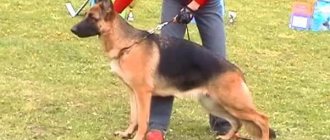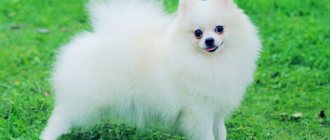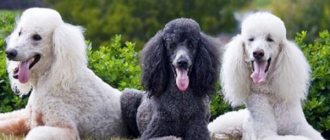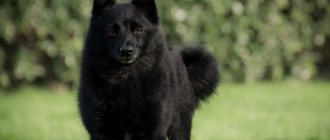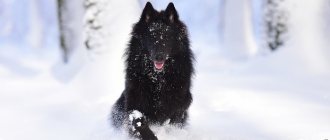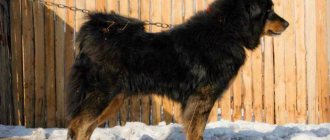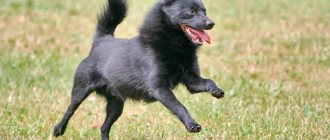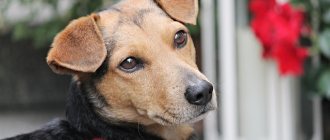Is the mongrel truly evil?
Some believe that street life must turn a mongrel dog into a fiend of hell, attacking other dogs and passers-by for no reason. To refute this fact, animal psychologists conducted a series of observations and found the following:
- most “yard terriers” do not show any aggression towards other yard dogs;
- mongrels are more wary of dogs with a pedigree that are different from them in appearance than Doberman Pinschers, Scottish and East European Shepherds, and Giant Schnauzers;
- “yard terriers” tend to show aggression towards humans more noticeably than Dobermans, boxers and collies, but they are inferior to special dogs in this ability;
- mongrel dogs are practically not inclined to show unreasonable aggression towards other dogs while walking: this ability is at the same level as that of friendly collies;
- For children, mongrels are not the most dangerous dogs: according to the rating of hostility towards children, they are inferior to Rottweilers, Caucasian Shepherds and “Germans”.
Mongrels show virtually no aggression towards their own kind.
Pros and cons of yard dogs
Little mongrels, like any other animal, have both their disadvantages and advantages. The advantages include:
- good health. The mongrel dog is practically not susceptible to hereditary diseases;
- easy adaptation to any conditions;
- ease of training and learning. Such animals completely lack fixed instincts. They are characterized by acute hearing, excellent sense of smell, and good watchdog qualities.
But a yard dog often shows aggression towards other animals.
This is its main disadvantage. Important ! A yard dog has a sharp mind, he has an instant reaction, the ability to instantly assess events happening around him. Yard dogs become very attached to their new owners
Mud Dog Clubs
There are now purebred dog clubs in many cities. They hold seminars on training, raising and training mongrel dogs, and exhibitions where you can show your dog in all its glory, regardless of breed. Dogs are evaluated based on the following characteristics: what the dog looks like, how well-groomed, well-mannered, obedient, and manageable it is. Pets take part in a costume competition and perform circus acts.
On social networks on Facebook there are “Roxy Club”, “Companion” club, “Druzhok”, “Lyon”. They are located in Moscow. The purpose of such organizations is to gather and unite the owners of mongrel animals, to prove that a simple mongrel is no worse than purebred dogs and differs from them only in appearance.
By picking up a homeless stray court terrier from the street, a person demonstrates his concern for his smaller brothers. With its help, another living soul finds a warm home and loving owners, who in turn receive a devoted, loving, faithful friend.
Shar Pei
A medium-sized breed from China, whose height rarely exceeds 50 cm at the withers, has a striking appearance. These animals cannot be confused with anyone else. The skin on the dog's body forms many folds. They are located throughout the animal's body. The largest number of them are concentrated on the withers, on the frontal part of the head, and also near the base of the curled tail. Plump hanging cheeks give the animal a kind appearance.
At the moment, you can find individuals of various shades, but brown dogs are considered the most aristocratic. The colors of animals of sand and bright chocolate color are recognized as officially confirmed.
Health and mind
First of all, it is believed that mongrel dogs grow stronger and healthier. This is due not only to natural selection under conditions of complex survival, but also to the highest heterozygosity. After all, purebred dogs are limited in the choice of partners for their offspring, so they are actually relatives. This cannot but leave an imprint on their physiology, immunity, and genetics. At the same time, one cannot talk about the absolute health of mongrel dogs. They also suffer from a number of genetic diseases and mental disorders. However, the more diverse ancestors a dog has in its pedigree, the stronger its immunity. Pure-bred individuals cannot boast of this.
The list of genetic abnormalities in outbred dogs is much shorter, especially in comparison with young breeds, where crossing also occurs between close relatives. Ancient breeds gradually weed out the bad gene from the population. For street servants, everything happens much faster; all genes that interfere with the survival process are eliminated.
Natural selection gradually shapes dogs that combine the best properties. They do not need to be constantly monitored by a veterinarian; with proper treatment, they can even cope with distemper.
The most common diseases among yard dogs:
- infectious diseases;
- eye diseases;
- skin problems.
Disorders of the gastrointestinal tract and blood diseases are less common. Babies under 2 months and older dogs are most susceptible to diseases. Regardless of the age at which a dog comes from the street to its owner, it is necessary to examine the animal
It is also important to carry out vaccination and antiparasitic treatment
Regarding the intelligence of mongrel dogs, there are many myths. Recent studies by Stockholm scientists have proven that the quality properties of purebred dogs decrease over time. Research has confirmed that people's craving for cute, cute and submissive animals has led to the fact that the laws of evolution cease to work. Therefore, it is far from the strongest who survive. The principles of modern dog breeding have led to the fact that the intellectual and behavioral abilities of breeds have decreased. Moreover, scientists were able to draw an alternative between appearance and intelligence. Most of the cutest toy breeds have the lowest mental abilities.
At the same time, dog experts stubbornly continue to assert that yard dogs are too stupid in comparison with purebred dogs. This is nothing more than a myth, since many mongrels can easily withstand competition with representatives of many breeds. Moreover, about 80% of mongrels have noble ancestors in their pedigree.
Differences in the appearance of babies
It is quite difficult for a non-professional to find the differences between a mongrel and a German shepherd, since this requires certain knowledge of the breed standard. However, it will still be possible to draw separate conclusions based on some distinctive features.
Coat and color
Appearance is an important criterion, knowledge of which will help in distinguishing German Shepherd puppies from crossbreeds. The fur of a purebred animal, although tactilely pleasant to the hand, is still hard. Yard individuals have soft hairs that feel like silk. The skin of an aristocratic person will look more elastic, without wrinkles.
The Sheepdog is characterized by a saddle-colored coat. The breed standard does not allow white spots on the chest. They are most often found in mongrel dogs.
The main features are the head
A rough or too light head will help a mongrel dog to distinguish itself. Shepherd dogs have a slightly convex frontal part with a weakly defined transition to the muzzle. The nasal lobe is large and deep black. Mutts can be distinguished by a strongly pronounced frontal groove.
Back and chest
Dogs should also differ in their chest. In a shepherd dog it is massive and well developed, while in a mongrel dog it is barrel-shaped.
Attention! Purebred dogs are distinguished by a short back that does not break in the lumbar region, without skidding.
Tail
When standing, a purebred individual has a saber-shaped, drooping tail. In the mongrel it is bent into a ring and rises above the back.
Paws
Experienced dog lovers recommend recognizing a purebred German Shepherd by the structure of its paws. They should be large, even and as long as necessary. This feature is most noticeable in puppies.
German Shepherd puppy paw
Weight
Thoroughbred animals quickly gain weight, which makes them different from mixed breeds and mongrels. Body weight should be determined depending on the age of the pet. The data should be checked against the indicators in this table:
| Age in months | Male weight, kg | Bitch weight, kg |
| 1 | 4,1 | 3,2 |
| 2 | 9 | 7,5 |
| 3 | 14,2 | 12 |
| 4 | 19 | 16,5 |
| 5 | 23 | 20 |
| 6 | 26,2 | 22,8 |
Interesting information! Mutts cannot gain weight at such a rate, so depending on how much the puppy weighs, you can determine its purebred.
Eyes
The eyes of the animal can indicate the purebredness of the animal. In the Shepherd, they are almond-shaped, intelligent and deep dark in color, although up to 2 months they can be gray-blue. In mongrels and mixed breeds, the eye organs are round and most often are in a bulging state.
Ears
A German Shepherd puppy's ears are soft, large and not erect until they are 6-8 months old. A mongrel can be identified by its clearly set ears.
Teeth
Before the change of teeth, a shepherd dog grows 28 milk teeth. Their fusion or malocclusion indicates deception by the breeder. A distinctive feature is scissor-shaped bites. The upper dental incisors are located above the lower ones, and the canines located at the top slightly overlap the lower ones. There should be no friction between them.
Frame
Shepherd puppies look harmonious. The head is not too large, although some awkwardness in appearance may occur during adolescence. The ears, tail and paws may be out of proportion to the body, as they grow faster.
Understanding
One of the main characteristics of a shepherd dog is its tendency to be trained from a young age. Already at the age of two months, the puppy is actively learning, quickly remembers command calls and willingly carries them out. A mongrel that looks like a shepherd dog cannot do this.
Note! A mongrel puppy will try to avoid human society. The fear of close contact is inherent in mongrels at the genetic level. Training a German is not a hassle
Mutt health
Unlike their purebred counterparts, mongrels are distinguished by good immunity and immunity to most diseases. Yard dogs can more easily tolerate weather changes and sudden temperature changes. These dogs are naturally endowed with very good health, this is explained by the fact that the blood of representatives of different breeds flows in their veins. In addition, in street conditions, very cruel natural selection often occurs.
Pedigree animals are the result of inbreeding (inbreeding), which negatively affects their health, while four-legged “street children” only become healthier from generation to generation.
Briard
A breed of French origin, its height reaches a maximum of 64 cm at the withers. A characteristic feature of a slender, medium-sized dog is long hair.
The animal's muzzle is flattened and completely covered with hair, under which thick eyebrows and black or dark brown eyes are hidden. The limbs of these pets are of medium size, but appear short due to the hair on them.
The colors of dogs can be different: black, gray, brownish, as well as two-tone with a smoothly transitioning coat color. Dogs are not subject to shedding, but require constant care to maintain hair color and quality.
Health and characteristic diseases
It is believed that mongrels get sick no less than purebred dogs, since their selection was influenced by man, not nature. Yard dogs, therefore, selected into their genotype a propensity for disease from the breeds with which they were crossed. Many people are interested in how long mongrel dogs live. The average range is 9–12 years, sometimes life expectancy can reach up to 20 years.
The most common diseases of court terriers:
- infectious;
- skin;
- ear, throat, nose and mouth;
- eye;
- circulatory system;
- Gastrointestinal tract;
- musculoskeletal system.
The most common disease among mongrels is distemper. It is fatal and mainly affects stray dogs or those living in unsightly, unkempt conditions. Vaccination can save you from the disease if you see a doctor on time. No less dangerous than distemper are tick bites for dogs.
When choosing a simple mongrel as a pet, remember that it needs care and love just like a purebred dog. Evaluate all the advantages and disadvantages of a court terrier and choose a worthy friend for yourself.
Bloodhound
An individual of a large species has a strong physique and good muscles. A well-proportioned dog grows up to 70 cm at the withers. The dog's large head with drooping cheeks gives the animal a serious, menacing appearance.
The Bloodhound has short, patchy hair that does not require special care. However, folds of skin located mainly on the face and neck area must be thoroughly washed to remove dirt every day.
The coat is not uniform. The drooping ears have a silky and fine hair texture, while the rest of the body is covered with longer and coarser hair. The colors of the animals are predominantly brown. The presence of light spots on the tip of the tail, sternum and paws is not considered a defect.
Character of the German Jagd Terrier
It is important to understand that the German Jagd Terrier does not exist outside of hunting, so buying a dog for yourself, children, or “for the sofa” and expecting aristocratic manners from it is not the most logical thing to do. However, even a yagd who regularly goes into the forest and works on animals is still obstinate
So say goodbye to the dream of making your pet an obedient “deliver” of slippers - this breed loves to cooperate, but not to serve and fawn.
The one who stole my heart
It is believed that professional training and early education can dampen the aggression and stubbornness of German Jagd Terriers, but there are also nuances here. Yes, a dog can be weaned from the habit of attacking strangers, but even an experienced dog handler will not be able to make him fall in love with a cat or another pet furry dog. Berries also attack small wild animals. For example, in rural areas, one of the main victims of the breed are hedgehogs. The black-and-tan “gladiators” are not stopped by either needles or the injuries they cause - reprisals against the prickly enemy are carried out immediately and to the bitter end.
It's the same story with unfamiliar dogs. German Jagdterriers have a strategic reserve of courage and the same amount of recklessness, therefore they are capable of provoking a conflict with their fellow tribesmen without any reason. The breed also has no time to understand the hierarchical system of the canine world, so even Yagd puppies easily go to extremes, such as encroaching on someone else’s bone or furiously attacking an adult wolfhound. Moreover, the larger the opponent, the more chances he has to infuriate the terrier - the impressive size of the opponent evokes a mixture of black envy and hatred among the “Germans”.
In a relationship with a person, Yagd prefers not to be scattered, but to concentrate on one person. Usually this is the one with whom the animal goes baiting and hunting. The dog recognizes the rest of the family members insofar as it is not in a hurry to fulfill their demands. The companion qualities of the breed are also tied to working instincts. The Jagdterrier will behave obediently during a walk only if there is someone nearby under whose leadership the animal is accustomed to hunting game. With all other household members, “feedback” will be episodic, so you can let your ward off the leash in the park in one and only case - if this park belongs specifically to you and there is not a single representative of wild fauna in it.
Kelpie
The species, bred in Australia, has a muscular body with flexible limbs. The height of adult individuals can reach 51 cm at the withers. The general appearance of this herding dog resembles that of a fox. The wide chest, short and compact legs make the breed incredibly tireless.
The individual has a double coat of medium length with a thick undercoat. It is longer under the body and on the back of the thighs than on the rest of the body. Just like many animals of Australian origin, the kelpie has a visual collar formed by longer fur.
The most common dogs are chestnut, yellow-brown and red-brown in color. Kelpies are slightly susceptible to shedding, but to maintain a shiny coat, they should be brushed every other day.
Attachment
One of the theories of dog handlers says that stray dogs do not become attached to people and easily change their owner and habitat. Statistics tell a different story. Only shepherd dogs are more loyal than court terriers. If we take all the cases when an animal waited for years for its owners near the road, or a dog died of hunger at the owner’s grave, then many of the heroes of these stories are mongrel.
If a dog is adopted from the street by a person, it becomes very attached to him and has a hard time experiencing separation. When she is taken to another house, the mongrel runs away to her old place of residence, even if the food and living conditions there are worse.
Mongrels become very attached to their owners
Despite the harsh living conditions, when they have to hide from people, mongrels are friendly and trust people. They themselves come up to ask for food and trustingly go if they are taken by their flocks.
Dogue de Bordeaux
French breed of large sizes. In the area of the animal's muzzle there are a large number of folds, symmetrically located on both sides. The height of a dog with a constant “sad” expression on its face can reach 68 cm.
Read Top 20 most expensive dogs - for the price of a good car
The most common color of the Bordeaux breed is brownish chestnut. Great Danes have a thick coat and thin hair. The color of the fur on the ears of animals is darker than on the rest of the body. To maintain the health of your Great Dane's coat, you need to brush your dog with a rubber brush at least 2-4 times a month. It is also recommended to clean the folds on the face with a damp cloth after each meal.
How to deal with the rebellious nature of a mongrel?
The character of some outbred individuals clearly shows rebellious behavior. For example, a mixed breed descended from a Stafford and a Labrador may not see a leader in its owner and often attack. Using the example of this rebellious puppy, we will find out how to deal with this behavior.
Table 4. Causes of bad dog behavior
| Poor behavior in a puppy: reasons | What to do? |
| Riot | The puppy does not agree with the role of a subordinate; he will look at the owner with a challenge, as if checking how he can respond. With this behavior, you need to strictly repeat the already assigned command |
| Puberty and the desire to dominate | During puberty, the dog becomes overly self-confident, the dog tries to take on the role of leader. He may refuse to carry out the command altogether or do it without much enthusiasm. |
| The owner's shouts | The owner's screams will only complicate the situation. The owner’s main weapon is strong character and self-confidence |
| The riot continues | You need to look firmly straight into the dog's eyes for it to understand that the person is not afraid. When the rebel's emotions begin to leave his face, the command must be repeated again |
If the rebel managed to be brought under control and he calmly follows the orders of the owner, half the battle is done
Another unnecessary habit is the desire to bite a person, and it does not matter what is caused by it - the desire to play or to show one’s leadership qualities. There are several ways to help stop your dog from biting:
- grab the puppy tightly by the nose and do not let go until his excited state passes;
- grab the dog's lower jaw when it tries to bite and apply gentle pressure on the tongue with your thumb;
- if the puppy begins to bite during the game, immediately stop it and express your dissatisfaction: the method works flawlessly;
- some owners bite the dog a couple of times as punishment, but this method can be dangerous: animals react instantly and can harm a person;
- If the puppy does not respond to the command “Fu!”, during the first lessons you can discreetly spank him on the backside with a newspaper so that he understands that punishment follows an unfulfilled command.
A puppy who is treated with understanding and love will obey his owner unconditionally
The main thing in raising a puppy is to be patient and persistent. The dog must be taught discipline and good behavior skills, as well as develop a subordinate attitude in it. The owner must be a leader who resolves conflict situations not with shouting and beatings, but with confident moral superiority.
Basenji
“The dog that doesn’t bark” is the second name of this unique breed. The short-haired individual has smooth, well-defined muscles. The height at the withers of an adult dog can reach a maximum of 43 cm. Representatives of the Basenji have: long legs, large erect ears and a tail curled into a ring. The folds on the forehead, which are well pronounced in Basenji puppies, give a special seriousness to the look.
Read The best dogs for an apartment - TOP 20 breeds
There are only six colors of the Basenji breed. One of the most popular is the brown color with white accents, which can appear on the dog’s belly, paws, tail or face.
What is a purebred dog
There are about 500 dog breeds in the modern world, and selection work with these animals continues. Depending on the degree of “pedigreedness,” dogs can be divided into 4 categories:
- Purebred (thoroughbred) animals. They are bred in nurseries, they have documents and their pedigree is known (the deeper into the past it goes, the better).
Husky is a fashionable breed that is easy to visually distinguish from a mongrel, but mixed breeds of the breed can be very similar to the original
Mixed breeds are jokingly called “designer” dog breeds for their uniqueness, because you can’t find another dog like them
Man's most loyal friends are ordinary mongrels
When buying a purebred animal secondhand, at best you can get a phenotype, and at worst, a mixed breed or a mongrel. Some buyers don't mind this because they want a dog with a certain appearance (for example, a spaniel with its beautiful coat and long ears) and not necessarily a purebred. However, in this case, no one can guarantee the buyer that the dog will have the character qualities specified by the breed, whereas in purebred animals, the characteristics of temperament and character are prescribed in the breed standard.
How to choose a puppy
Check to see if your puppy has two dewclaws on each of his hind legs.
Do not be tempted to choose the largest and fattest baby in the litter; most likely, as he matures, he will not fit into the standard height parameters. The most trustworthy are nurseries and breeders who check their breeding stock for hip dysplasia. After passing an examination by a radiologist, future sires must receive an A or B mark. Typically, breed-class briards pass standards according to the IPO-1 system. If the puppy’s parents were able to score at least 17 points out of a possible 20 in the IPO tests, their offspring are considered promising. In the first months of life, puppies look like mongrels and bear very little resemblance to real Briards. Don't let this bother you As your furballs get older, their appearance will change significantly. The appearance of the mother and father of the puppies plays an important role, so focus on the quality and thickness of their coat, which the babies will inherit in 99 cases out of 100. Choose neat, cheerful puppies, without signs of an umbilical hernia, as well as signs of diarrhea under the tail.
Dog breeds similar to mongrels. 3. Mutts are naturally loyal and intelligent dogs.
Mongrel dogs are historically focused on survival, so they show ingenuity and cunning in difficult situations. They can be trained, but at the same time they do not want to please the owner, like their purebred brothers, but try for the sake of delicacy. The mongrel always takes care of himself. She can bark loudly, guarding her territory, but on the street, if the owner is attacked, she will run away. This is how the instinct of self-preservation manifests itself.
Guard dogs are inferior to mongrels in the ability to decide something on their own. But in case of danger, they will give their lives for you - this is how the breeders bred them.
The breed in this case is a guarantee of character and exterior.
All representatives of the same breed will be similar to each other. Both in appearance and in character. This is their advantage: you can always choose a dog to your liking.
In the case of a mongrel, you always get a “pig in a poke” - you don’t know what to expect from the dog in terms of character and psyche, whether this animal will be aggressive or cowardly, what size a small puppy can grow to, etc. But at the same time, a mongrel is always an original beauty and individuality.
Popular types of mestizos
Mixed breeds are dogs that are born by crossing two different breeds.
They do not differ at all in their characteristics from their purebred counterparts. But, at the same time, they can seriously differ in appearance and character.
When it comes to health and learning ability, mixed breeds are often superior to purebred dogs in these indicators.
The most common dachshund mixes:
- Spaniel mix. The dog usually takes on the characteristics of both parents, but is more reminiscent of a spaniel, with the difference that such a pet has a longer body and a more explosive character.
- A Jack Russell cross is not a large, very active dog, similar in color to a Jack Russell, and similar in body structure to a dachshund. The dog is active, devoted to its owner, and does not tolerate loneliness well.
- A hybrid with a Chihuahua has an elongated body structure, a miniature muzzle and widely spaced ears. This is a loving, active, sociable animal, easily trainable and does not tolerate loneliness well.
- The Yorkshire Terrier mix is playful, active, and quick to learn. Such animals are very friendly, get along well with children and others and pets, have the appearance of a dachshund and the character of a Yorkie.
- Spitz mix. In size and body structure, it is more like a dachshund, and its coat is more like a spitz. This dog is very mobile, active and fearless. At the same time, he is proud and stubborn, and is also difficult to train.
- The pug cross has a strong body, many folds and an elongated body. The dog has a calm and good-natured character.
- The beagle cross looks very harmonious, it has a slightly elongated body, medium-height paws and smooth fur. These dogs are active and good-natured.
- Welsh Corgi mix. These pets are very cute and have a cheerful character.
Hunting with a German Jagdterrier
Hunters
The breed is universal and works excellently underground, on land, in water, but all this is subject to high-quality training and baiting. It is believed that individuals from Soviet lines were angrier to the beast than their today's descendants, but in general the yagds retained the purity of hunting instincts and phenomenal viscosity. The German Jagdterrier is an excellent retriever of small game, and especially waterfowl. Representatives of the family are ready to dive for a shot bird into a body of water of any depth, without suffering at all from low temperatures. For example, there are cases when animals fished for a trophy even during ice drift.
If desired, the dog can be involved in gun hunting to search for wounded animals, as well as to bait wild boar. However, in the second case, a support group consisting of representatives of hound breeds will be required. But the real element of the German Jagdterrier was and remains holes. Moreover, it is not recommended to bring your pet to a direct fight in the hole. The yagd's task is to hold off the predator until the hunter arrives. If the dog gets too excited and tries to deal with the fox or badger on his own, he needs to be pulled out of the underground labyrinth by the tail.
The first baiting should be carried out no earlier than the animal is 8-10 months old. For this purpose, they use a “walking” fox that keeps a decent distance and does not fight back the pursuer. Remember that a puppy at this age has an unstable psyche, and aggressive game can discourage him from hunting for the rest of his life. You can build a hole for training yourself, or you can use ready-made designs for baiting stations. The main thing is not to put pressure on the dog and not push it into the maze. The Jagdterrier himself should become interested in the hole and dive into it.
The first to practice the skills of searching and pursuing the beast. The second stage is training in anger and grip, and it is recommended to “use” the latter skill on a raccoon. Unlike the fox and badger, this minke whale is not capable of causing serious injury to a pet. Some hunters bait jags on stray cats, but this method is not recommended because it teaches the dog to view domestic animals as potential game. By the way, among professionals, Jagdterriers are especially valued because they do not tear the animal to pieces, but competently dodge its claws.
How to understand what a puppy's character will be?
It's quite simple:
- if a puppy whines, runs away and hides, shakes in horror at the sight of a stranger, most likely he will grow up to be a cowardly-aggressive dog, yapping indiscriminately at all external stimuli (strangers, other animals, a doorbell, the sound of a car passing outside the window, etc.) .P.);
- if a puppy, at the sight of a stranger, boldly rushes at him, barks, tries to bite, serious problems with obedience and aggressive (including biting) behavior in the future are possible;
- if the baby comes up to you (even if hesitantly, but comes up when called), licks his hands, wags his tail, he is probably all right mentally and does not expect any special problems with obedience (of course, with proper upbringing).
Principles of training
Many mongrel dogs are highly intelligent. According to these characteristics, they are superior to purebred animals. They are easy to train and remember commands well. The advantage of such pets is that they do not have fixed instincts. From them you can make a dog that meets all the owner’s requirements.
As soon as a new pet appears in the house, you need to introduce it to the feeding area. Such dogs quickly remember where they need to sleep, their nickname, and begin to immediately respond to it. After this, you can teach the animal to simple commands: sit, lie down. The patience and skill of the owner will help turn even a non-noble breed of dog into an intellectual.
Mongrels are excellent hunters and watchdogs. They are often found in country houses, housed in enclosures and kennels. They tolerate living conditions well on the street, as they have strong immunity.
Domestic dogs have very developed protective instincts.
Who is better to have such dogs?
Beautiful pooches often become members of celebrity families. Many show business stars have mongrel pets. For example, the Russian model Bondarchuk Svetlana has three dogs at home. She picked them all up on the street.
Yard animals are suitable for absolutely everyone. These are excellent and loyal friends. This pet is a good option for elderly lonely people. The animal requires minimal care; it does not require feeding with expensive products, long and exhausting walks and jogs. The uniqueness of mongrels lies in their humanity. They are so grateful that they were sheltered that they very quickly adapt to the rhythm of life and the requirements of the new owner. The dog immediately understands what is expected of him and begins to behave accordingly.
Yard dogs do not need constant training. They grow up obedient even in the process of systematic education. In contrast, purebred dogs need to be intensively trained and educated; for example, Rottweilers without this will be dangerous to others.
Interesting fact ! The well-known first dogs, the cosmonauts Belka and Strelka, were mongrels.
Use of dogs by humans
Dog handlers often claim that “door terriers” are significantly inferior to their four-legged counterparts in terms of characteristics (discipline or keen sense of smell). Despite this:
- they have proven themselves well as service animals for searching for missing people or things;
- the four-legged guard is in no way inferior to his more eminent brothers due to his high devotion;
- As watchdogs, mongrel dogs are slightly inferior to service dogs, but they are still better in terms of performance than collies or boxers.
For narrowly focused tasks, it may be worth thinking about purchasing purebred specimens, however, this does not mean that “door terriers” are not as good as their counterparts.
Dvorterrier intelligence
There are simply no equals to mongrels in terms of intelligence. More than 80% of surveyed owners of this breed claim that their pets are incredibly smart, are able to assess a situation in a short time, and also make important decisions with lightning speed, and understand how to behave correctly in certain conditions.
In terms of independent behavior, the mongrel is second only to Caucasian Shepherds, leaving behind all other purebred animals. Mongrels quickly master the rules of behavior in the house; only Caucasian Shepherds and Giant Schnauzers are ahead of “yard animals” in this matter.
Irish Setter
A type of setter of impressive size with an elongated head and a bushy tail. Animals with elongated legs and neck can grow up to 67 cm in height.
A beautiful, energetic breed with a tall stance, it is famous for its beautiful, shiny fur. The dog's rich brown fur varies in length. Longer, wavy hair is found on the back of Setters' legs, as well as on the chest and tail.
Irish Setters range in color from a bright brown, almost red, to a less rich chestnut brown.
Unusual and memorable ossipom
To create it, a Pomeranian Spitz was crossed with an Australian Shepherd. The result was a very beautiful and unusual dog with bright colors. Ossipoma has a very small size, a playful temperament and a constantly good mood. This pet is famous for its charm among other hybrids of different breeds. The Ossipom dog is capable of charming and making any person fall in love with it. The creature has received absolutely all the good features of a shepherd and a Pomeranian. Ossipom is valued for his flexible behavior, intelligence, and hard work, which helps him quickly learn various tricks. Already from puppyhood, this dog can perfectly demonstrate its skills in training.
Many owners of this dog hybrid note the amazing loyalty of their pet. He can sit at the door all day waiting for his owner to arrive. With it, he turns into a restless and happy bundle of energy.
Ossipom needs long walks in the fresh air. The animal will tirelessly run and play, enjoying physical activity. Therefore, everyone who wants a cheerful and cheerful friend will find him in the form of this dog.
Doberman
A strong, strong and muscular dog. The Doberman is famous for its elegant physique: with a fairly high height, which can reach 72 cm at the withers, it does not look massive.
The Doberman is an animal with a proportional head, a massive neck and a scissor bite. At first glance it may seem dangerous, but the almond-shaped, clear eyes indicate otherwise.
The Doberman's coat is short and shiny, and lies close to the body. Brownish and tan hair color is more common than other shades. The color of the animal varies from black-brown to yellowish-brown. Dobermans without characteristic tan marks are not considered purebred. Caring for a brown Doberman coat is simple. Combing your pet with a brush once a week and wiping it with a damp towel is all that is required from the owner to maintain healthy coloring.
Factors influencing life expectancy
Pedigree is not the primary influence on a dog's life expectancy. There are a number of factors that determine how long a particular dog can live:
- Dimensions of the animal. There is a general relationship - the larger the dog, the shorter its life expectancy. This is explained by the fact that a large weight creates a large load on the body; dogs of gigantic size more often suffer from diseases of the heart, joints and digestive tract. In addition, it is more difficult for a large dog to find enough food on the street.
- Genetic diseases. The presence of congenital pathologies in a particular individual directly affects its life. But it is worth noting that hereditary pathologies are less common in mongrels than in purebred dogs - in the process of natural selection, animals with defective genes are eliminated, which gives mongrel dogs good health.
- Food quality. Eating spoiled food, leftovers from human meals, or long periods of fasting - all this greatly shortens the life of any animal. But a complete diet, providing the mongrel with everything necessary, will be a significant contribution to its longevity.
- Conditions of detention. Any mongrel dog that lives in the house with its owner and is regularly walked will live no less than a purebred dog, and due to good health, probably longer. If the dog is kept outside, then it should have a warm and dry kennel in case of bad weather, as well as the opportunity to run around the area for at least several hours a day. The best option is when the dog is kept on a chain during the day and released at night to guard the territory.
Basic colors
According to breed standards, the color of the Bull Terrier must be white.
In this case, skin pigmentation does not matter. However, other colors are also acceptable, the owners of which can also participate in exhibitions and win prizes.
White
White is considered the most common and preferred color, with the standard allowing for spots of a different color on the face, head, neck or ears. Even in this case, the color will be considered white.
But, if there are spots on the body or legs, the color will be considered white with markings.
Ginger
Red is considered a color in which the dog is completely covered with red hair. In this case, the shade can be anything, from dark brown to light red.
However, a very light color is considered fawn and is undesirable as it leads to lower points in shows.
Black
A completely black color in a Bull Terrier is extremely rare; in most cases, such dogs have white spots on their paws, face or neck, but in this case, the color will be considered two-tone.
Two-color (bicolor)
The bi-colored Bull Terrier may have areas of white, and these may be located on the paws, tail, muzzle or chest.
The main condition is that white spots should not occupy more than 50% of the body surface.
Tricolor
This color may include:
- Black.
- Ginger.
- White.
- Brown.
According to the standard, a tricolor dog should have no more than 50% white. Other colors must be clearly distinguishable and can be of any proportion.
brindle
As a rule, in such pets the red color acts as the main color and is complemented by black stripes. At the same time, the standards allow black color as the main color with red stripes.
White markings are also allowed on the entire body except the muzzle. If white spots are present on the face, then the color is considered brindle-white.
Grey
This color is quite rare and, as a rule, is a sign of a non-purebred dog.
Animals of this color are usually not allowed to exhibit and do not participate in breeding work.
Brown
Brown color is considered one of the variants of red and can have any shades except fawn.
Fawn coloring is considered undesirable and such dogs are not allowed for breeding.
Yard dog breeds. Health of "yard terriers"
Mongrel dogs have good immunity and are able to resist most diseases. They calmly tolerate weather changes and sudden temperature changes. Purebred dogs, as opposed to street dogs, often come from crossing related individuals, which is why their health suffers. And mongrels are only becoming healthier from generation to generation. Good health is also explained by the fact that genetically, each representative contains the characteristics of several breeds at once. In addition, on the streets where most mongrels grow up, strict natural selection often occurs.
Mongrels have good health
However, yard dogs can pick up diseases from the breeds with which they were crossed. So, among mongrel dogs the following are common:
- diseases of the ears, eyes, throat;
- infectious diseases;
- lesions of the musculoskeletal system;
- gastrointestinal diseases.
As a rule, individuals in infancy, older dogs and animals with weak immune systems are susceptible to diseases. Infectious diseases develop quickly and can be fatal. Distemper is the most common disease among mongrels, which mainly affects unkempt dogs that live in unsanitary conditions, or stray dogs.
The difference between mongrels, mestizos and purebreds
Depending on the preferences of the dog owner, he praises mongrels or endows them with bad qualities. Let's start by defining the main groups of animals
If we do not take into account the inhabitants of the wild, then dogs living near humans are divided into groups:
- purebred;
- mestizos;
- mongrels.
Is the difference between these groups so great, given the history of their origin and the definition of their status? Some purebred dogs look ugly, but mongrels, if you look at photos of dogs, are very attractive.
When a puppy is picked up on the street and brought to a veterinary clinic for vaccinations, the breed is written as “mixed breed” in its passport. According to the definition of dog handlers, a mestizo is a puppy from dogs of 2 different breeds. In principle, this definition suits the court terrier.
A mixed breed is a puppy from two different breeds.
A new breed is registered only when its characteristics are consistently transmitted to puppies when breeding dogs of this species. But how are new breeds created, where do elite dogs come from? Representatives of different species interbreed, and at the genetic level, selection occurs for certain external traits. Often used at the initial stage are mongrels, wild dogs and wolves. In the process of creating a new canine aristocrat, it is extremely rare to make do with 2 types, usually there are much more of them. Breeders can use representatives of several breeds, on average 6 - 8. Well, who is the mongrel after that?
The description of the breed includes height, color, ear shape and other elements. Any new species can be characterized by comparison with others: ears like a shepherd, a bulldog's muzzle, and everything else too. The disadvantage of purebred dogs in inbreeding is the small number of individuals, and therefore relatives are crossed.
Among the photos of mongrels there are a lot of unique beauties. Difficult living conditions and natural selection created an animal of a special breed and certain qualities - the mongrel.
Among the mongrels there are very beautiful dogs
Main characteristics of mongrel dogs:
- patient;
- calm;
- devotees;
- quickly learn the rules of behavior;
- smart;
- smart;
- friendly;
- playful.
History of the German Jagd Terrier breed
The breed was formed at the beginning of the 20th century, when dog breeders, fed up with show terriers, began to dream of working pets that could bring real benefits. By that time, European exhibitions were filled with representatives of the group with an exemplary exterior, but absolutely unsuitable for working on the animal due to muted instincts. After the First World War, German specialists began breeding a new, purely hunting variety of terrier, ideally working in a hole.
The pioneer in this matter was the dog breeder and part-time passionate fan of fox terriers Walter Zangenberg, who was later joined by Rudolf Fries and Karl-Erich Grunewald. The breeder began his experiments by taking four fox terrier puppies from the director of the Munich Zoo, Lutz Heck. Zangenberg was not embarrassed that the babies had a vicious black and tan color, since the breeder intended to develop hunting instincts in the animals, and not a glamorous appearance. As a result, the matured puppies were bred with black foxes, known for their phenomenal viciousness and tirelessness in pursuing prey.
Smooth coated German Jagdterrier
Wirehaired German Jagdterrier
In 1926, the first Jagdterrier club opened in Germany, and 12 months later Zangenberg’s charges began to be exhibited at an exhibition. At first, the breed was bred by inbreeding (inbreeding), which did not have the best effect on the health of the offspring. And only in the 20s did dog breeders begin to involve more distant relatives - Welsh Terriers and Old English Terriers - in training jags. After World War II, breeding of the breed was no longer as active, which was facilitated by the division of Germany into occupation zones. In addition, the breeders of the GDR relied on Zangenberg’s breeding research, that is, they continued to cross Jagd relatives with each other. As a result, the dog population quickly recovered, but the number of defective individuals began to grow exponentially.
International recognition came to the Jagdterrier in 1954, along with the receipt of the FCI standard. After this event, dogs began to be exported to North and South America, but the small and nimble jags did not make the right impression on the hunters of the New World. German terriers were brought to the USSR in the 70s, although unofficial sources claim that the first acquaintance of domestic breeders with the breed took place 40 years earlier. Of the manufacturers imported to the Soviet Union, Cherry von Rischebach, Dina von Hochlitzee, and Encke von Wolzi-Gersee are especially noteworthy. It was these individuals that laid the foundation for the first generations of Russian Jagd Terriers.
Why do people get mongrels?
Most people simply cannot resist the sight of a stray animal on a cold street. It is also worth noting that mongrels are often owned by owners who are quite capable of affording a purebred animal with a good pedigree . But this does not mean at all that people will love the mongrel less than its purebred brother. You can be proud of any pet, and in gratitude he will give you his devotion and affection.
In the Soviet Union, it was quite difficult to purchase a purebred dog, so ordinary mongrel animals did all the hard work. They acted as rescuers and border guards, artists and watchmen, helped customs officers and were bloodhounds for the police. All these versatile qualities, undoubtedly, cannot overshadow the advantages of “purebreds,” but they will make it possible to notice mongrels against the background of purebred specimens.
Choosing and purchasing a purebred puppy
Buying a purebred dog is no less important than purchasing a purebred dog. You always take a “pig in a poke”; no one can give you guarantees of what size the puppy will grow, what heredity and mental health it has.
The only thing that can undoubtedly please us is that outbred puppies are either completely free, or are given for a nominal fee “in good hands.” Or you can show your good will and adopt a puppy or older dog from a shelter. By the way, many foster kennels offer dogs that have already been sterilized and treated for parasites for adoption, which makes life easier for the new owner.
You may be offered to pay for some of the veterinary services provided to your dog, but this is rare and is more voluntary. Volunteers are simply glad that the dog finds a home, and financial assistance is a secondary, although important, issue.
But if you still decide to just take a dog from the street, then, regardless of its age, provide the entire range of medical services for the dog, from deworming to vaccinations. Take care of your new pet, because what will eventually grow out of the mongrel baby depends only on its owner and his efforts invested in the dog.
Sources
- https://zveridoma.com/sobaki/porody-sobak/dvorterer-besporodnye-sobaki/
- https://kinpet.ru/dvornyazhka/
- https://prohvost.club/sobaki/porody-sobak/dvornyazhki-sobaki-foto.html
- https://www.Purina.ru/dogs/getting-a-new-dog/finding-the-right-dog-for-me/pooch
- https://pets2.me/bok/495-sobaka-dvorterer-ili-dvornyaga-sobaka-ne-huzhe-porodistyh.html
- https://vplate.ru/sobaki/dvornyagi/
- https://porodadog.ru/razmery-sobak/sobaka-dvornyazhka-stoit-li-brat-stol-riskovoe-zhivotnoe-v-dom-i-chego-zhdat-ot-milogo-komochka.html
[collapse]
How to tame a stray dog?
Puppies without a breed are not a scarce segment. Where exactly you decide to take non-pedigreed dogs doesn’t really matter. Small mongrels are sold in markets, through online resources, and can be adopted from dog shelters. However, there are rules that should be followed when choosing a pet, then taming it will become less difficult.
- Assess the area where the dog lives and how well the parents’ living conditions comply with sanitary standards. If everything is neglected and dirty, the dog may be sick.
- Pay attention to the appearance. It should be healthy, there should be no pus or inflammation on the mucous membranes. A healthy dog's nose is wet and its belly is not distended.
- Assess your temperament. Too lethargic, apathetic, cowardly, aggressive - not the best option. An adequate puppy is curious, cheerful, active, energetic, and playful.
We recommend reading: Pitbulls: myths and truth, description of the breed, character
The biggest problem during taming will be cowardly puppies. Growing into adult dogs, they will rush at passers-by and strangers. It will be almost impossible to wean them off this. Friendliness is the first sign of a child’s mental health. He may be cautious, this is normal, but after a short period of time he will definitely show interest, sniff, and wag his tail. It will be quite easy to tame such a yard dog.
Very often, mongrels come to their owners directly from the street. If you decide to shelter and rescue just such a dog, you need to take some measures. First, take the puppy to the veterinarian, check his health and age, there he will be given the necessary assistance and vaccinated.
Before picking up a dog, try to find its possible owners. She could have gotten lost, or she could have been kicked out, for example, due to aggression or inappropriate behavior.
Most often, dogs are either born on the street or end up there due to the dishonest attitude of their owners. After you've interviewed your neighbors, posted notices, made sure the dog is a nobody's, and visited the veterinarian, you can take it home. The algorithm of actions in this case is similar to that when buying a puppy. Prepare a place for him, feed him, give him a good rest, and get used to it. The dog needs to sleep and adapt, to feel safe.
When giving your dog food for the first time, do not burden its stomach, which is unaccustomed to good food; let the feeding be modest and light. Cottage cheese, broth, porridge are perfect. Be sure to give your dog something to drink. You should not immediately begin education; in the first days, demanding complete obedience is pointless. A dog that falls into the wrong hands experiences stress and needs time to adapt. Put aside practice, learning and games for a while.
The first step is to establish relationships and bring them to a trusting, friendly level. This is achieved by affectionate treatment, regular feeding, and care. After waiting a few days in this way, you can contact a veterinarian to assess your state of health and psyche. Vaccination and treatment against parasites should be carried out. After this, you can wash the dog and put on a special flea collar.
Proper training of a street dog will lead to a grateful attitude and devotion. But instincts acquired on the street will periodically make themselves felt; the dog’s behavior should be monitored at this time. Otherwise, the dog may run away and become homeless again. To prevent this from happening, do not leave your pet alone for a long time, behave in a friendly manner, and take care of it.
Behavior characterized by dog owners as rebellious can cause some trouble for the owner. Not all yard dogs are susceptible to this, but you need to know how to behave in such cases. If among the dog's ancestors there were breeds that were independent in character, the dog may exhibit such qualities.
- Rebellion is the behavior of denial, when the dog does not obey, its gaze is defiant, and the role of leader is being tested. It is necessary first of all to pronounce a command that has already been learned - “no” or “fu”.
- Puberty period. At this time, the dog becomes independent, overly self-confident and tries to challenge leadership. The rebellion may not be too pronounced.
- Scream. Yelling at a dog only provokes it to continue its rebellion. Never raise your voice at a dog, consistency and severity are the best methods of training and education.
- If the riot drags on , make eye contact with the dog, look confidently and calmly. This is the best way to prove your leadership. After the dog calms down, the command is repeated again.
If the dog follows commands, it means that the riot has been extinguished. You can say that you are halfway to success.
Biting is another inappropriate habit of yard dogs. It doesn’t matter at all what motivation drives the dog – play or aggression. In any case, you will have to get rid of this during the taming process. There are several methods to achieve this goal:
- gripping the nose, which continues until the animal calms down;
- grasping the lower jaw during a bite attempt, while applying light pressure with a finger on the tongue area;
- playful biting should cause an immediate cessation of play and expression of dissatisfaction with the behavior;
- you cannot bite the dog back;
- Failure to comply with the command to stop the action may be accompanied by a light slap on the butt with a newspaper.
To tame a dog from the street, you will have to show firmness, perseverance and character. You need to be calm, confident, but consistent in your actions. Remember that discipline is something that needs to be taught to a mongrel as early as possible. Moreover, the owner’s leadership should be expressed in moral superiority, and not in assault and shouting.
Pet food
Another clear advantage of mongrels over other breeds. Dogs do not have a pampered stomach, so they do not need a special diet , while their purebred counterparts require a balanced diet, which costs a lot of money. Your mongrel friend will be very happy if you feed him porridge in meat broth with the addition of meat twice a day.
Also, do not forget that the animal will be happy with any goodies from your table; the only thing that should not be given to the dog is sweet foods, which can give it a toothache.
What is a mongrel, origin of the breed
Any breed of dog is the result of selection, with the help of which certain qualities inherent in this breed are achieved. Over the years, these qualities have been improved and consolidated. A mongrel dog - this can also be said to be the result of selection, which took place without human participation. Not only stray animals take part in it, but also domestic ones, whose owners do not really bother themselves with proper care for them.
The most numerous breed
Here, the breeder-selector is nature itself, natural selection; it is impossible to trace the pedigree of such pets. Not all people are indifferent to the fate of homeless animals. Shelters are organized and money is collected for their maintenance.
Monuments to mongrels were erected:
- In Mexico City. Peluso the mongrel calls for compassion for homeless animals.
- Florence. The dog waited for 14 years for his owner who died in the war.
- A monument to the homeless dog Jock has been erected in Krakow.
- In Moscow, dedicated to the stray dog Boy.
- Vologda - a dog peeing on a lamp post.
- Tyumen - a piggy bank dog helps collect donations for the needs of stray animals.
- In Kemerovo, with the money of the townspeople, a monument was erected to a stray dog resting on a manhole cover.
Monument to the mongrel Peluso in Mexico
